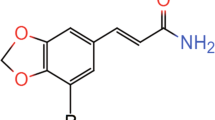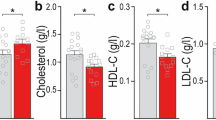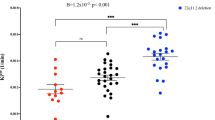Abstract
D1A-null mice were backcrossed over 14 generations into a C57BL/6 background to result in essential elimination (to <0.005%) of any contribution from the 129/Sv component of their initially mixed (129/Sv×C57BL/6) background. Their phenotype was assessed using an ethologically based approach that resolves each individual topography of behaviour in the natural repertoire. Habituation of sniffing, locomotion, rearing seated, and rearing to wall in wild types over several hours was profoundly retarded in congenic D1A mutants; conversely, rearing free and sifting were essentially abolished. Resultant increases in individual topographies of behaviour were substantially greater in congenic D1A mutants than in those on a mixed background. This phenotype was little altered by the selective D1-like antagonist SCH 23390 and could not be blocked by the selective D2-like antagonist YM 09151-2. The selective D1-like agonist SK&F 83959 could not further elevate those behaviours already heightened in congenic D1A mutants, while the induction of stereotyped sniffing and plodding locomotion by the selective D2-like agonist RU 24213 was disrupted. Genetic background appears to modulate critically the magnitude but not the general nature of the D1A-null phenotype, which may involve compensatory processes independent of other D1-like or D2-like receptors.
Similar content being viewed by others
Log in or create a free account to read this content
Gain free access to this article, as well as selected content from this journal and more on nature.com
or
References
Andringa G, Drukarch B, Leysen JE, Cools AR, Stoof JC (1999). The alleged dopamine D1 receptor agonist SKF 83959 is a dopamine D1 receptor antagonist in primate cells and interacts with other receptors. Eur J Pharmacol 364: 33–41.
Arnt J, Hyttel J, Sanchez C (1992). Partial and full dopamine D1 receptor agonists in mice and rats: relation between behavioural effects and stimulation of adenylate cyclase activity in vitro. Eur J Pharmacol 213: 259–267.
Carter TA, Del Rio JA, Greenhall JA, Latronica ML, Lockhart DJ, Barlow C (2001). Chipping away at complex behavior: transcriptome/phenotype correlations in the mouse brain. Physiol Behav 73: 849–857.
Clifford JJ, Kinsella A, Tighe O, Rubinstein M, Grandy DK, Low MJ et al (2001). Comparative, topographically based evaluation of behavioural phenotype and specification of D1-like:D2-like interactions in a line of incipient congenic mice with D2 dopamine receptor ‘knockout’. Neuropsychopharmacology 25: 527–536.
Clifford JJ, Tighe O, Croke DT, Sibley DR, Drago J, Waddington JL (1998). Topographical evaluation of the phenotype of spontaneous behaviour in mice with targeted gene deletion of the D1A dopamine receptor: paradoxical elevation of grooming syntax. Neuropharmacology 37: 1595–1602.
Clifford JJ, Tighe O, Croke DT, Kinsella A, Sibley DR, Drago J et al (1999). Conservation of behavioural topography to dopamine D1-like receptor agonists in mutant mice lacking the D1A receptor implicates a D1-like receptor not coupled to adenylyl cyclase. Neuroscience 93: 1483–1489.
Clifford JJ, Usiello A, Vallone D, Kinsella A, Borrelli E, Waddington JL (2000). Topographical evaluation of behavioural phenotype in a line of mice with targeted gene deletion of the D2 dopamine receptor. Neuropharmacology 39: 382–390.
Crabbe JC, Wahlsten D, Dudek BC (1999). Genetics of mouse behavior: interactions with laboratory environment. Science 284: 1670–1672.
Crawley JN, Belknap JK, Collins A, Crabbe JC, Frankel W, Henderson N et al (1997). Behavioral phenotypes of inbred mouse strains: implications and recommendations for molecular studies. Psychopharmacology 132: 107–124.
Cromwell HC, Berridge KC, Drago J, Levine MS (1998). Action sequencing is impaired in D1A-deficient mutant mice. Eur J Neurosci 10: 2426–2432.
Deveney AM, Waddington JL (1995). Pharmacological characterization of behavioural responses to SK&F 83959 in relation to ‘D1-like’ dopamine receptors not linked to adenylyl cyclase. Br J Pharmacol 116: 2120–2126.
Drago J, Gerfen CR, Lachowicz JE, Steiner H, Hollon TR, Love PE et al (1994). Altered striatal function in a mutant mouse lacking D1A dopamine receptors. Proc Natl Acad Sci USA 91: 12564–12568.
Gerlai R (1996). Gene-targeting studies of mammalian behaviour: is it the mutation or the background genotype. Trends Neurosci 19: 177–181.
Gnanalingham KK, Hunter AJ, Jenner P, Marsden CD (1995). Stimulation of adenylate cyclase activity by benzazepine D-1 dopamine agonists with varying efficacies in the 6-hydroxydopamine lesioned rat—relationship to circling behaviour. Biochem Pharmacol 49: 1185–1193.
Kelly MA, Rubinstein M, Phillips TJ, Lessov CN, Burkhart-Kasch S, Zhang G et al (1998). Locomotor activity in D2 dopamine receptor-deficient mice is determined by gene dosage, genetic background, and developmental adaptations. J Neurosci 18: 3470–3479.
Kido Y, Philippe N, Schaffer AA, Accilli D (2000). Genetic modifiers of the insulin resistance phenotype in mice. Diabetes 49: 589–596.
Lariviere WR, Chesler EJ, Mogil JS (2001). Transgenic studies of pain and analgesia: mutation or background genotype? J Pharmacol Exp Ther 297: 467–473.
Mahan LC, Burch RM, Monsma Jr FJ, Sibley DR (1990). Expression of striatal D1 dopamine receptors coupled to inositol phosphate production and Ca2+ mobilization in Xenopus oocytes. Proc Natl Acad Sci USA 87: 2196–2200.
Moratalla R, Xu M, Tonegawa S, Graybiel AM (1996). Cellular responses to psychomotor stimulant and neuroleptic drugs are abnormal in mice lacking the D1 dopamine receptor. Proc Natl Acad Sci USA 93: 14928–14933.
Nadeau JH (2001). Modifier genes in mice and humans. Nat Rev Genet 2: 165–174.
Niznik HB, Sugamori KS, Clifford JJ, Waddington JL (2002). D1-like dopamine receptors: molecular biology and pharmacology. In: Di Chiara G (ed). Handbook of Experimental Pharmacology: Dopamine in the CNS. Springer: Heidelberg, 121–158.
Panchalingham S, Undie AS (2001). SKF 83959 exhibits biochemical agonism by stimulating [35S]GTPγS binding and phos-phoinositide hydrolysis in rat and monkey brain. Neuropharmacology 40: 826–837.
Phillips TJ, Hen R, Crabbe JC (1999). Complications associated with genetic background effects in research using knockout mice. Psychopharmacology (Berl) 147: 5–7.
Ralph RJ, Paulus MP, Geyer MA (2001). Strain-specific effects of amphetamine on prepulse inhibition and patterns of locomotor behavior in mice. J Pharmacol Exp Ther 298: 148–155.
Rogers DC, Jones DN, Nelson PR, Jones CM, Quilter CA, Robinson TL et al (1999). Use of SHIRPA and discriminant analysis to characterise marked differences in the behavioural phenotype of six inbred mouse strains. Behav Brain Res 105: 207–217.
Sandberg R, Yasuda R, Pankratz DG, Carter TA, Del Rio JA, Wodicka L et al (2000). Regional and strain-specific gene expression mapping in the adult mouse brain. Proc Natl Acad Sci USA 97: 11038–11043.
Sanford LP, Kallapur S, Ormsby I, Doetschman T (2001). Influence of genetic background on knockout mouse phenotypes. In: Tymms MJ, Kola I (eds). Gene Knockout Protocols. Humana Press Inc: Totowa, NJ, 217–226.
Sibley DR (1999). New insights into dopaminergic receptor function using antisense and genetically altered animals. Annu Rev Pharmacol Toxicol 39: 313–341.
Smith DR, Striplin CD, Geller AM, Mailman RB, Drago J, Lawler CP et al (1998). Behavioural assessment of mice lacking D1A dopamine receptors. Neuroscience 86: 135–146.
Undie AS, Friedman E (1990). Stimulation of a dopamine D1 receptor enhances inositol phosphates formation in rat brain. J Pharmacol Exp Ther 253: 987–992.
Undie AS, Weinstock J, Sarau HM, Friedman E (1994). Evidence for a distinct D1-like dopamine receptor that couples to activation of phosphoinositide metabolism in brain. J Neurochem 62: 2045–2048.
Waddington JL, Clifford JJ, McNamara FN, Tomiyama K, Koshikawa N, Croke DT (2001). The psychopharmacology-molecular biology interface: exploring the behavioural roles of dopamine receptor subtypes using targeted gene deletion (‘knockout’). Prog Neuropsychopharmacol Biol Psychiatry 25: 925–964.
Waddington JL, Daly SA, McCauley PG, O'Boyle KM (1994). Levels of functional interaction between D1-like and D2-like dopamine receptor systems. In: Niznik HB (ed). Dopamine Receptors and Transporters. Marcel Dekker: New York, 511–537.
Waddington JL, Deveney AM, Clifford J, Tighe O, Croke DT, Sibley DR et al (1998). D1-like dopamine receptors: regulation of psychomotor behaviour, D1-like:D2-like interactions and effects of D1A targeted gene deletion. In: Jenner P, Demirdamar R (eds). Dopamine Receptor Subtypes. IOS Press: Amsterdam, 45–53.
Xu M, Hu XT, Cooper DC, Moratalla R, Graybiel AM, White FJ et al (1994a). Elimination of cocaine-induced hyperactivity and dopamine-mediated neurophysiological effects in dopamine D1 receptor mutant mice. Cell 79: 945–955.
Xu M, Moratalla R, Gold LH, Hiroi N, Koob GF, Graybiel AM et al (1994b). Dopamine D1 receptor mutant mice are deficient in striatal expression of dynorphin and in dopamine-mediated behavioral responses. Cell 79: 729–742.
Acknowledgements
These studies were supported by the Research Committee of the Royal College of Surgeons in Ireland, the Stanley Medical Research Institute and a Galen Fellowship from the Irish Brain Research Foundation, in the Institute of Biopharmaceutical Sciences under the Higher Education Authority's Programme for Research in Third Level Institutions. We thank Hoechst-Marion-Roussel for RU 24213 and Yamanouchi for YM 09151-2. SK&F 83959 was provided by Research Biochemicals International as part of the Chemical Synthesis Program of the National Institute of Mental Health, Contract No. N01MH30003.
Author information
Authors and Affiliations
Corresponding author
Rights and permissions
About this article
Cite this article
McNamara, F., Clifford, J., Tighe, O. et al. Congenic D1A Dopamine Receptor Mutants: Ethologically Based Resolution of Behavioural Topography Indicates Genetic Background as a Determinant of Knockout Phenotype. Neuropsychopharmacol 28, 86–99 (2003). https://doi.org/10.1038/sj.npp.1300008
Received:
Revised:
Accepted:
Published:
Issue date:
DOI: https://doi.org/10.1038/sj.npp.1300008
Keywords
This article is cited by
-
Dopamine Receptor Mediation of the Exploratory/Hyperactivity Effects of Modafinil
Neuropsychopharmacology (2011)
-
Neuroprotective effects of a novel kynurenic acid analogue in a transgenic mouse model of Huntington’s disease
Journal of Neural Transmission (2011)
-
Differential susceptibility to ethanol and amphetamine sensitization in dopamine D3 receptor-deficient mice
Psychopharmacology (2009)
-
Association of the calcyon gene (DRD1IP) with attention deficit/hyperactivity disorder
Molecular Psychiatry (2005)
-
Phenotypic studies on dopamine receptor subtype and associated signal transduction mutants: insights and challenges from 10 years at the psychopharmacology–molecular biology interface
Psychopharmacology (2005)



